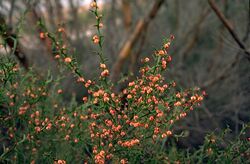Biology:Daviesia decipiens
| Daviesia decipiens | |
|---|---|

| |
| Near Boxwood Hill | |
| Scientific classification | |
| Kingdom: | Plantae |
| Clade: | Tracheophytes |
| Clade: | Angiosperms |
| Clade: | Eudicots |
| Clade: | Rosids |
| Order: | Fabales |
| Family: | Fabaceae |
| Subfamily: | Faboideae |
| Genus: | Daviesia |
| Species: | D. decipiens
|
| Binomial name | |
| Daviesia decipiens (E.Pritz.) Crisp[1]
| |
Daviesia decipiens is a species of flowering plant in the family Fabaceae and is endemic to the south-west of Western Australia. It is an intricately-branched shrub with scattered, sharply-pointed oblong or tapering phyllodes, and orange, maroon and crimson flowers.
Description
Daviesia decipiens is an intricately-branched, glabrous shrub that typically grows to a height of up to 1.8 m (5 ft 11 in). Its leaves are reduced to scattered, sharply-pointed oblong or tapering phyllodes 5–25 mm (0.20–0.98 in) long and 2–8 mm (0.079–0.315 in) wide. The flowers are arranged singly or in pairs in leaf axils on a peduncle 1.0–2.5 mm (0.039–0.098 in) long, each flower on a pedicel 0.75–1.5 mm (0.030–0.059 in) long with bracts about 0.5 mm (0.020 in) long at the base. The sepals are 3–4 mm (0.12–0.16 in) long and joined at the base, the two upper lobes forming a broad lip and the lower three triangular. The standard petal is elliptic, 5.0–6.5 mm (0.20–0.26 in) long, 5.5–8.0 mm (0.22–0.31 in) wide and orange with maroon markings, the wings 4.5–5.0 mm (0.18–0.20 in) long and red, and the keel 4.5–5.0 mm (0.18–0.20 in) long and crimson. Flowering occurs from June to September and the fruit is an inflated, triangular pod 11–12 mm (0.43–0.47 in) long.[2][3]
Taxonomy and naming
This daviesia was first formally described in 1904 by Ernst Georg Pritzel who gave it the name Daviesia pectinata var. decipiens in the Botanische Jahrbücher für Systematik, Pflanzengeschichte und Pflanzengeographie.[4][5] In 1995, Michael Crisp raised the variety to species status as Daviesia decipiens.[6] The specific epithet (decipiens) means "deceiving".[7]
Distribution and habitat
Daviesia decipiens grows in woodland, mallee and kwongan between Chidlow, Narrogin, Kalgan and Ravensthorpe in the Avon Wheatbelt, Esperance Plains, Jarrah Forest and Mallee biogeographic regions of south-western Western Australia.[3][2]
Conservation status
Daviesia decipiens is classified as "not threatened" by the Western Australian Government Department of Biodiversity, Conservation and Attractions.[2]
References
- ↑ "Daviesia decipiens". Australian Plant Census. https://biodiversity.org.au/nsl/services/apc-format/display/139361.
- ↑ 2.0 2.1 2.2 "Daviesia decipiens". FloraBase. Western Australian Government Department of Parks and Wildlife. https://florabase.dpaw.wa.gov.au/browse/profile/16579.
- ↑ 3.0 3.1 Crisp, Michael D.; Cayzer, Lindy; Chandler, Gregory T.; Cook, Lyn G. (2017). "A monograph of Daviesia (Mirbelieae, Faboideae, Fabaceae)". Phytotaxa 300 (1): 224–226. doi:10.11646/phytotaxa.300.1.1.
- ↑ "Daviesia decipiens var. decipiens". APNI. https://id.biodiversity.org.au/instance/apni/500846.
- ↑ Pritzel, Ernst (1904). "Fragmenta Phytographiae Australiae occidentalis. Beitrage zur Kenntnis der Pflanzen Westaustraliens, ihrer Verbreitung und ihrer Lebensverhaltnisse". Botanische Jahrbücher für Systematik, Pflanzengeschichte und Pflanzengeographie 35 (2–3): 250. https://www.biodiversitylibrary.org/page/126721#page/279/mode/1up. Retrieved 25 November 2021.
- ↑ "Daviesia decipiens". APNI. https://id.biodiversity.org.au/instance/apni/556954.
- ↑ Sharr, Francis Aubi; George, Alex (2019). Western Australian Plant Names and Their Meanings (3rd ed.). Kardinya, WA: Four Gables Press. p. 179. ISBN 9780958034180.
Wikidata ☰ Q15532085 entry
 |

